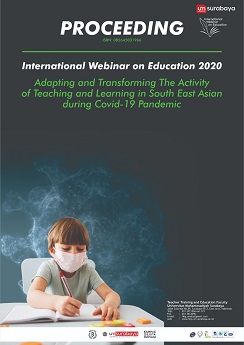Student‟s Perception of Online Learning in Pandemic
Abstrak
Abstract.
This study aimed to explore the perceptions of student‘s in an implementation of
online learning in pandemic era. This new phenomenon where currently the educators and students are grappling with the idea, innovation, problem solving skills to implementation and adaptation. Especially, with the development of ICT and relative exposure of students to it, this study examines student‘s perception about online learning which help in a newer teaching and learning experiences on the campus. The Ministry of Education and Culture recommends learning from home using online learning. Primary Teacher Education Program Study in STKIP Muhammadiyah Bangka Belitung (STKIP MBB) has been implemented online learning to use the LMS, social media, and some application to supported learning process. This was a descriptive strudy involved an analysis of survey of student regarding their perception on online learning. Technique the sample collection used
simple random sampling on 1st, 2nd, and 3rd years primary teacher education in STKIP MBB about 150 student‘s. The data were collected through questionnaires of the student‘s perception of online learning. The data analysis used descriptive analysis. The result of this study was student‘s perception of online learning to use varied media or application in the course has a somewhat good category (38,75%) for implementation and the student‘s suggestion to start What‘s App, Google Meet or Zoom Application.
Referensi
A. Level, ―Impact of the 2019 – 20 coronavirus pandemic on education,‖ pp. 1–36, 2020.
Z. Almarzooq, M. Lopes, and A. Kochar, ―Virtual Learning during the COVID-19 Pandemic: A Disruptive Technology in Graduate Medical Education,‖ J. Am. Coll. Cardiol., 2020, doi: 10.1016/j.jacc.2020.04.015.
M. C. Rodriguez, A. Ooms, and M. Montañez, ―Students‘ perceptions of online-learning quality Given comfort, motivation, satisfaction, and experience,‖ J. Interact. Online Learn., vol. 7, no. 2, pp. 105–125, 2008.
Y. T. Yang and R. D. Silverman, ―Social distancing and the unvaccinated,‖ N. Engl. J. Med., vol. 372, no. 16, pp. 1481–1483, 2015, doi: 10.1056/NEJMp1501198.
E. Shim, ―Optimal strategies of social distancing and vaccination against seasonal influenza,‖ Math. Biosci. Eng., vol. 10, no. 5–6, pp. 1615–1634, 2013, doi:
3934/mbe.2013.10.1615.
D. A. Armstrong, ―Students‘ perceptions of online learning and instructional tools: A qualitative study of undergraduate students use of online tools,‖ Turkish Online J. Educ. Technol., vol. 10, no. 3, pp. 222–226, 2011.
L. Fedynich, K. S. Bradley, and J. Bradley, ―Graduate students‘ perceptions of online learning,‖ Res. High. Educ. J., vol. 27, no. 27, pp. 1–13, 2015.
S. Erduran, ―Science Education in the Era of a Pandemic,‖ Sci. Educ., vol. 29, no. 2, pp. 233–235, 2020, doi: 10.1007/s11191-020-00122-w.
K. L. Smart and J. J. Cappel, ―Students‘ Perceptions of Online Learning: A Comparative Study,‖ J. Inf. Technol. Educ. Res., vol. 5, no. June 2006, pp. 201–219, 2006, doi: 10.28945/243.
C. Keller and L. Cernerud, ―Students‘ Perceptions of Eâ€learning in University Education,‖ J. Educ. Media, vol. 27, no. 1–2, pp. 55–67, 2002, doi: 10.1080/1358165020270105.
R. A. Eldeeb, ―Students‘ Perceptions to e-learning,‖ IOSR J. Res. Method Educ., vol. 4, no. 3, pp. 33–36, 2014, doi: 10.9790/7388-04343336.
K. R and M. Vinayak Mahajan, ―A study of students‘ perception about e-learning,‖ Indian J. Clin. Anat. Physiol., vol. 5, no. 4, pp. 501–507, 2018, doi: 10.18231/2394- 2126.2018.0116.
K. C. Aberg, K. C. Doell, and S. Schwartz, ―Linking individual learning styles to approachavoidance motivational traits and computational aspects of reinforcement learning,‖ PLoS One, vol. 11, no. 11, pp. 1–16, 2016, doi: 10.1371/journal.pone.0166675.
G. Mayende, A. Prinz, and G. M. N. Isabwe, ―Improving communication in online learning systems,‖ CSEDU 2017 - Proc. 9th Int. Conf. Comput. Support. Educ., vol. 1, no. April, pp. 300–307, 2017, doi: 10.5220/0006311103000307.
M. Hölbl and T. Welzer, ―Students‘ feedback and communication habits using moodle,‖ Elektron. ir Elektrotechnika, vol. 6, no. 6, pp. 63–66, 2010, doi:
5755/j01.eee.102.6.9354.
Z. Zakariah, N. Alias, M. N. A. Aziz, and N. Z. Ismail, ―E-Learning Awareness in a Higher Learning Institution in Malaysia,‖ Procedia - Soc. Behav. Sci., vol. 67, no. November 2011, pp. 621–625, 2012, doi: 10.1016/j.sbspro.2012.11.368.
N. Eskilsson and J.-M. Suorsa, ―Students‘ Perceptions of Learning Management SystemsAn Explorative Case Study of Upper Secondary School Students.,‖ 2014.
A. Horvat, M. Dobrota, M. Krsmanovic, and M. Cudanov, ―Student perception of Moodle learning management system: a satisfaction and significance analysis,‖ Interact. Learn. Environ., vol. 23, no. 4, pp. 515–527, 2015, doi: 10.1080/10494820.2013.788033.
E. Akman and H. Karaaslan, ―Student Perceptions on Learning By Design Method in a Learning Management System : a Case Study,‖ no. October, pp. 6–8, 2010.
D. M. Poole, ―Student Participation in a Discussion-Oriented Online Course,‖ J. Res. Comput. Educ., vol. 33, no. 2, pp. 162–177, Dec. 2000, doi: 10.1080/08886504.2000.10782307.






